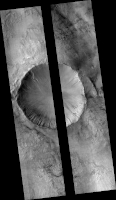
Map Projected Browse Image
Click on image for larger versionGullies are commonly found in the Martian mid-latitudes, particularly in the Southern Hemisphere. However, they are rare in the deepest parts of the massive Hellas impact basin.
One likely reason for this is that gullies are found on steep slopes, which seem to be less common in Hellas. For this image, HiRISE targeted a relatively fresh crater where previous images from the MRO Context Camera appeared to show gullies. This high-resolution look confirms the gullies and will allow scientists to compare them in detail with gullies elsewhere on the planet.
The map is projected here at a scale of 50 centimeters (19.7 inches) per pixel. (The original image scale is 51.9 centimeters [20.4 inches] per pixel [with 2 x 2 binning]; objects on the order of 156 centimeters [61.4 inches] across are resolved.) North is up.
The University of Arizona, in Tucson, operates HiRISE, which was built by Ball Aerospace & Technologies Corp., in Boulder, Colorado. NASA's Jet Propulsion Laboratory, a division of Caltech in Pasadena, California, manages the Mars Reconnaissance Orbiter Project for NASA's Science Mission Directorate, Washington.

